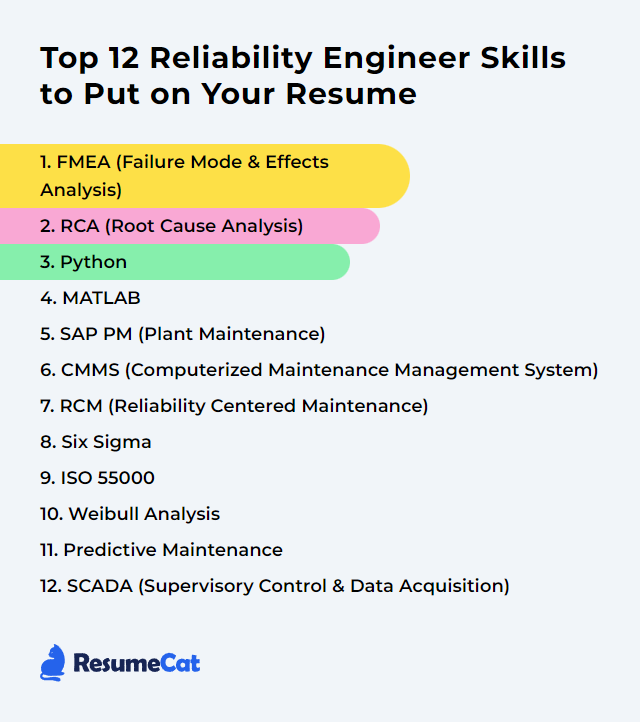Top 12 Reliability Engineer Skills to Put on Your Resume
In today's competitive job market, standing out as a reliability engineer means showing a sharp blend of technical acumen and people skills. Put the skills that prove you can keep complex systems steady, safe, and profitable right up front—recruiters notice fast when you make reliability tangible.
Reliability Engineer Skills
- FMEA (Failure Mode and Effects Analysis)
- RCA (Root Cause Analysis)
- Python
- MATLAB
- SAP PM (Plant Maintenance)
- CMMS (Computerized Maintenance Management System)
- RCM (Reliability Centered Maintenance)
- Six Sigma
- ISO 55000
- Weibull Analysis
- Predictive Maintenance
- SCADA (Supervisory Control and Data Acquisition)
1. FMEA (Failure Mode and Effects Analysis)
FMEA (Failure Mode and Effects Analysis) is a structured method to uncover how a product or process might fail, gauge the consequences, and drive actions that shrink risk before it bites.
Why It's Important
FMEA helps a Reliability Engineer surface potential failure modes early, rank what matters most, and put preventive actions in motion—boosting safety, uptime, and customer trust.
How to Improve FMEA (Failure Mode and Effects Analysis) Skills
Make FMEA sharper, not heavier. Focus on accuracy, flow, and follow-through:
Cross-Functional Teamwork: Pull voices from design, manufacturing, quality, operations. Real failures hide in interfaces; diverse inputs flush them out. ASQ’s guidance on team roles is a useful north star.
Prioritize with Action Priority (AP): Move beyond raw RPN. The AIAG & VDA FMEA Handbook shifts focus to Action Priority (AP), which better directs effort and avoids the RPN blind spots. If your industry still uses RPN, use it alongside severity-driven AP thinking.
Living Documents: Keep your FMEAs alive. Update after test results, design revisions, field feedback, and process tweaks. Standards from SAE outline good maintenance discipline.
Training and Competence: Refresh the team’s FMEA skills periodically. New team members and evolving methods make short training bursts worthwhile. Reliabilityweb offers practical resources.
Leverage Tools: Use FMEA software to maintain consistency, version control, metrics, and collaboration. Choose tools that integrate with your PLM/CMMS where possible.
Integrate with DfR and RCA: Tie FMEA outputs to Design for Reliability, verification plans, and Root Cause Analysis. NREL’s integration guidance captures how these pieces click together.
Do this well and your FMEA becomes a decision engine, not a checkbox exercise.
How to Display FMEA (Failure Mode and Effects Analysis) Skills on Your Resume
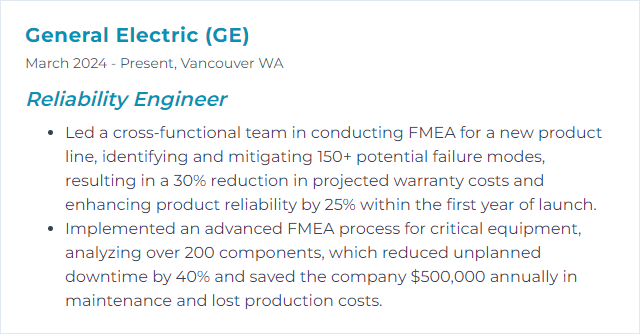
2. RCA (Root Cause Analysis)
Root Cause Analysis finds the underlying reasons failures happen, not just the symptoms, and locks in fixes that prevent recurrence.
Why It's Important
RCA boosts reliability by targeting the true drivers of failure. That means fewer repeats, steadier performance, and better use of maintenance dollars.
How to Improve RCA (Root Cause Analysis) Skills
Sharper RCAs come from discipline and data:
Define Precisely: Pin down what failed, where, when, and to what extent. Use 5 Whys to peel the layers cleanly.
Collect Rich Data: Pull logs, sensor traces, maintenance history, and operating context. FMEA can hint at likely culprits.
Map Causes: Cause-and-effect (fishbone) diagrams expose categories you might miss under pressure.
Select Targeted Actions: Tie fixes directly to causes. For complex chains, Fault Tree Analysis helps separate necessary from nice-to-have actions.
Implement and Verify: Pilot changes, measure impact, and adjust. Don’t declare victory early.
Document and Share: Record cases, context, evidence, and outcomes. Build a searchable knowledge base.
Improve the Process: Bake continuous improvement into your RCA workflow. Short retrospectives after each case keep the edge sharp.
How to Display RCA (Root Cause Analysis) Skills on Your Resume

3. Python
Python is a clean, expressive language for automation, analytics, and glue code—great for parsing logs, crunching time-series, scripting simulations, and stitching together tooling.
Why It's Important
For reliability engineers, Python turns messy data into signals and tedious tasks into one-liners. You can prototype fast, analyze faster, and ship tools your teams will actually use.
How to Improve Python Skills
Level up with focused practice:
Core Fluency: Nail syntax, functions, classes, and packaging. The Python Official Tutorial is compact and solid.
System Automation: Automate file handling, job scheduling, and report generation. Automate the Boring Stuff shows practical patterns.
Robustness: Master exceptions, logging, and typing. The Python documentation on errors and exceptions is worth a close read.
Data Stack: Get comfortable with pandas, NumPy, SciPy, and plotting libraries. For survival/reliability, explore lifelines and reliability tooling.
DevOps Touchpoints: Use Docker, Kubernetes basics, and CI/CD (e.g., GitHub Actions) to make scripts deployable and repeatable.
Infrastructure as Code: Learn Terraform and write small reproducible environments for testing analytics pipelines.
Version Control: Git fluency pays off. The Pro Git Book remains a great reference.
Observability: Wire up Prometheus exporters, parse logs, and build alerts. The Elastic stack is handy for centralized logging.
Performance: Profile, vectorize, and cache. High Performance Python offers concrete tactics.
Contribute: Engage with open source to learn patterns and code quality at scale. GitHub is a deep pool of examples and issues.
How to Display Python Skills on Your Resume
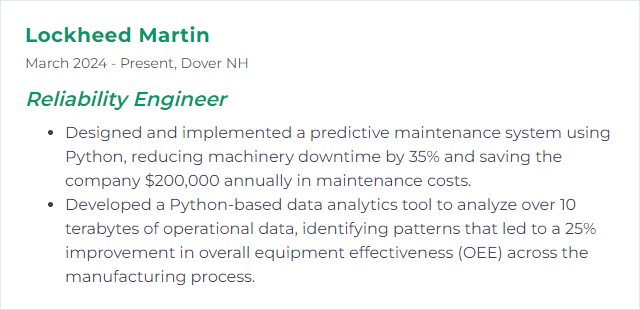
4. MATLAB
MATLAB offers high-level numerical computing, rich visualization, and toolboxes that make modeling, simulation, and reliability analysis straightforward. When data needs math-heavy treatment, it shines.
Why It's Important
Reliability work leans on modeling and statistics. MATLAB speeds up prototyping, parameter sweeps, and scenario testing—then communicates results clearly.
How to Improve MATLAB Skills
Make learning practical:
Guided Courses: Structured courses (e.g., Coursera, Udemy) keep momentum and provide projects.
Official Tutorials: MATLAB Onramp and documentation get you hands-on with examples that map to engineering problems.
Projects: Build small studies on degradation, accelerated life testing, or Monte Carlo reliability. Kaggle-style datasets can help.
Community: MATLAB Central is a strong place to grab code snippets, ask questions, and share results.
Books: MATLAB for Engineers (Holly Moore) helps bridge concepts to execution.
Add-Ons: Bring in toolboxes for statistics, optimization, signal processing, or reliability-focused workflows.
How to Display MATLAB Skills on Your Resume
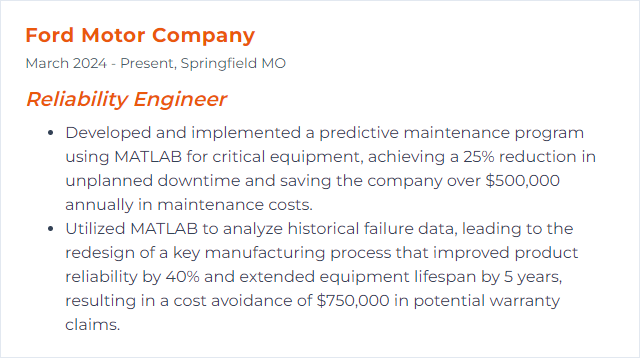
5. SAP PM (Plant Maintenance)
SAP PM helps plan, execute, and record maintenance. It centralizes asset history, streamlines work orders, and turns maintenance data into decisions.
Why It's Important
With SAP PM, a Reliability Engineer can reduce downtime, standardize preventive programs, and monitor costs—all with traceability that stands up to audits.
How to Improve SAP PM (Plant Maintenance) Skills
Make the system work for you, not the other way around:
Clean Master Data: Get equipment, functional locations, BOMs, and task lists accurate and consistently named. Review and cleanse regularly.
Maintenance Strategies: Configure time-based and condition-based plans aligned to RCM outcomes. Tie notifications to failure codes that mean something.
User Adoption: Train maintainers and planners on the specific transactions, variants, and reports they’ll touch every day. Short, role-based sessions win.
Module Integration: Integrate with MM, PP, and QM to sync spares, production schedules, and quality holds. Visibility improves decisions.
Analytics: Use standard KPIs (MTBF, MTTR, PM compliance, backlog health) and dashboards. SAP Analytics Cloud or similar tools help tell the story.
Continuous Improvement: Review failure codes, plan effectiveness, and feedback loops quarterly. Tune frequencies, scopes, and spare strategies.
How to Display SAP PM (Plant Maintenance) Skills on Your Resume
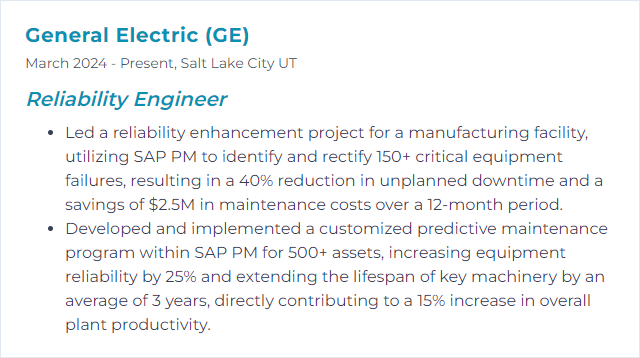
6. CMMS (Computerized Maintenance Management System)
CMMS software tracks assets, manages work, and stores histories. For reliability engineering, it’s the memory of the plant and the engine for execution.
Why It's Important
A CMMS standardizes scheduling, lifts preventive and predictive programs, reduces emergency work, and uncovers trends that cut costs and downtime.
How to Improve CMMS (Computerized Maintenance Management System) Skills
Turn your CMMS into a trusted source:
Data Quality: Define data standards, run periodic audits, and purge duplicates. Bad data quietly breaks decisions.
Role-Based Training: Train techs, planners, and supervisors on their workflows—mobile entries, failure coding, kitting, closeout quality.
Integrations: Connect ERP, SCADA/IIoT, and condition monitoring to remove swivel-chair data entry.
Mobile First: Enable real-time updates from the floor with photos, parts scans, and meter reads.
KPIs and Reports: Track PM compliance, emergency work ratio, backlog age, wrench time, and first-pass yield.
Preventive to Predictive: Use condition data to migrate time-based PMs to smarter triggers. Cut over-maintenance and catch early failures.
Feedback Loops: Encourage tech notes and post-job reviews. Small insights pile up to big gains.
Vendor Partnership: Lean on your vendor for configuration reviews, new features, and roadmap alignment.
How to Display CMMS (Computerized Maintenance Management System) Skills on Your Resume
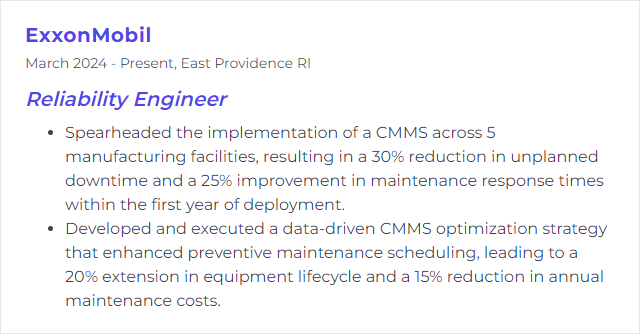
7. RCM (Reliability Centered Maintenance)
RCM picks the right maintenance for each failure mode—no more, no less—based on risk and function. It aligns maintenance with how equipment actually fails.
Why It's Important
Done well, RCM cuts reactive work, improves safety, and extends life. Costs fall where risk is low, and attention shifts to where it counts.
How to Improve RCM (Reliability Centered Maintenance) Skills
Keep it practical and data-driven:
Master the Principles: Define functions, functional failures, failure modes, and effects—then choose the appropriate tasks. Reliabilityweb houses strong primers.
Use Analytics: Pair RCM with condition monitoring and predictive models to set thresholds and intervals that evolve with evidence.
Train the Team: Upskill planners, engineers, and technicians on criticality, task selection logic, and failure coding. SMRP programs can help.
Continuous Improvement: Revisit strategies after major failures, design changes, or seasonal shifts. Borrow from Six Sigma for structured control.
Integrate with CMMS/EAM: Build RCM decisions into job plans, task lists, and spares. Systems like Maximo or Fiix can embed logic.
Proactive Mindset: Emphasize preventive and predictive techniques such as vibration analysis, lubrication analysis, and thermography. The Mobius Institute offers solid training.
Stakeholder Buy-In: Include operators and leadership early. Better insights, stronger adoption.
How to Display RCM (Reliability Centered Maintenance) Skills on Your Resume
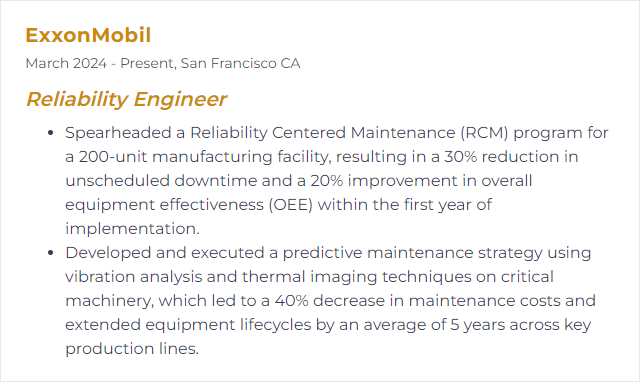
8. Six Sigma
Six Sigma reduces variation and defects using data and structured problem-solving. In reliability, that translates into steadier processes and fewer surprises.
Why It's Important
DMAIC and statistical thinking let you find hidden drivers of instability, tighten tolerances, and lift capability—reliability improves as variance shrinks.
How to Improve Six Sigma Skills
Keep it evidence-first:
Solid Foundations: Learn DMAIC deeply—scoping, data collection planning, and control sustain the gains.
Statistical Tools: Use Minitab or similar for capability, hypothesis tests, DOE, and regression. You’ll move from hunches to proof.
Reliability Focus: Apply tools to lifetime data, accelerated tests, and warranty analysis. Software from ReliaSoft and similar suites can help.
Link to the Floor: Tie projects to scrap, rework, yield, uptime, or safety metrics. Results should show up in the plant, not just in slides.
Keep Learning: Short courses (Coursera, LinkedIn Learning) and communities keep skills current.
Network: Engage with Lean Six Sigma groups to trade approaches and templates that actually work.
How to Display Six Sigma Skills on Your Resume
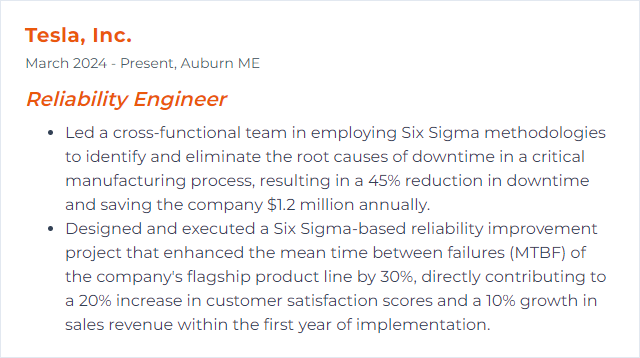
9. ISO 55000
ISO 55000 frames asset management at a strategic level. In practice, organizations often implement ISO 55001 (requirements) and use ISO 55002 (guidance) to build an asset management system that aligns cost, risk, and performance across the lifecycle.
Why It's Important
For reliability engineers, ISO 55000-series thinking ties daily maintenance to organizational aims. You balance availability, risk, and spend with intent—not guesswork.
How to Improve ISO 55000 Skills
Build maturity step by step:
Know the Series: Understand the roles of ISO 55000 (overview), 55001 (requirements), and 55002 (guidance).
Gap Analysis: Assess your current practices against 55001. Prioritize gaps with clear owners and timelines.
Improvement Plan: Address risk management, lifecycle planning, criticality analysis, and change control. Keep it practical.
Enable with Tech: Use EAM/CMMS, condition monitoring, and analytics platforms to drive data-driven decisions.
Competence: Train teams on asset management principles and reliability best practices. RMC and SMRP materials are helpful.
KPIs and Review: Define leading and lagging indicators. Review routinely, refine relentlessly.
Stakeholder Alignment: Communicate strategy and trade-offs with finance, operations, and HSE. Everyone owns reliability.
Iterate: Embed continuous improvement and capture lessons learned in your system of record.
How to Display ISO 55000 Skills on Your Resume
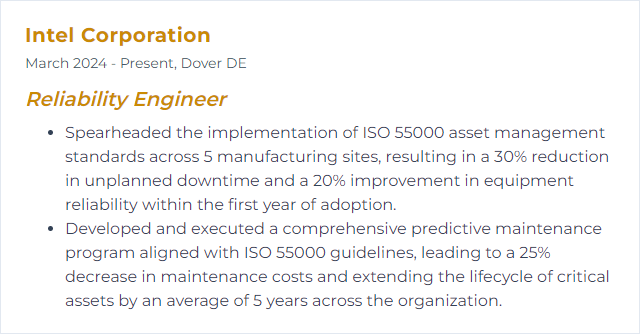
10. Weibull Analysis
Weibull Analysis models life data to reveal failure patterns—early-life issues, random failures, wear-out—and predicts reliability over time.
Why It's Important
It guides warranty strategies, maintenance intervals, spares stocking, and design improvements by quantifying how and when things fail.
How to Improve Weibull Analysis Skills
Precision matters:
Quality Data: Capture full histories: run times, loads, environments, and exact failure definitions. Garbage in, garbage out.
Censoring: Handle right-censored and interval-censored data correctly. Survival methods exist for a reason—use them.
Model Choice: Choose 2-parameter or 3-parameter Weibull as data dictates. Validate with goodness-of-fit and residual checks.
Tools: Reliability analysis software (e.g., Weibull++-class tools) simplifies fitting, plotting, and sensitivity analysis.
Keep Current: Read, attend workshops, and compare methods with peers in reliability communities.
Cross-Validate: Review assumptions with statisticians and field engineers. Fresh eyes catch shaky inferences.
How to Display Weibull Analysis Skills on Your Resume
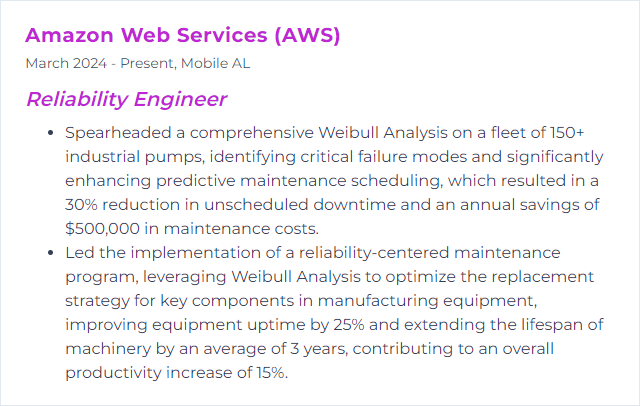
11. Predictive Maintenance
Predictive maintenance uses condition data and analytics to forecast failures, so you fix equipment at the right time—not too late, not too soon.
Why It's Important
It trims unplanned downtime, reduces maintenance spend, and stretches asset life. Reliability climbs when your interventions are timely and targeted.
How to Improve Predictive Maintenance Skills
Build a data-to-action pipeline:
Data and Sensors: Instrument assets with meaningful signals—vibration, temperature, oil analysis, electrical signatures. High-quality, synchronized data is the backbone.
Real-Time Monitoring: Stream to a historian or time-series database. Alert on context-aware thresholds, not just raw limits.
Analytics and ML: Use feature engineering, anomaly detection, and survival models. Cloud ML platforms can speed exploration.
Verification: Validate predictions with inspections and tests. Tighten models with feedback from the field.
Upskill the Team: Train maintainers and engineers to interpret signals and trust the system.
Iterate: Review false positives/negatives, update thresholds, and expand to new assets once you see ROI.
How to Display Predictive Maintenance Skills on Your Resume

12. SCADA (Supervisory Control and Data Acquisition)
SCADA monitors and controls industrial processes in real time. It gathers data from sensors and equipment, enabling analysis, alarming, and safe interventions.
Why It's Important
For reliability engineering, SCADA provides visibility into asset health and process conditions, helping detect anomalies early and coordinate fast responses.
How to Improve SCADA (Supervisory Control and Data Acquisition) Skills
Harden, observe, and evolve:
Maintenance and Updates: Keep software/firmware current and document changes. Patch hygiene is reliability hygiene.
Cybersecurity: Segment networks, apply least privilege, monitor traffic, and audit regularly. Follow recognized ICS security guidance.
Redundancy: Add redundancy to servers, comms, and power. Design for graceful degradation, not cliff-edge failure.
Analytics and PdM: Stream SCADA data to historians and analytics platforms. Turn trends into predictive alerts.
Training: Run drills on alarm floods, comms loss, and failovers. Teach operators alarm rationalization principles (e.g., ISA-18.2).
Modernize: Upgrade legacy PLCs/RTUs and adopt standards like OPC UA. Old protocols can be fragile and opaque.
Network Design: Use DMZs, strict firewalling, and secure remote access. Reference ICS network architecture best practices.
How to Display SCADA (Supervisory Control and Data Acquisition) Skills on Your Resume

